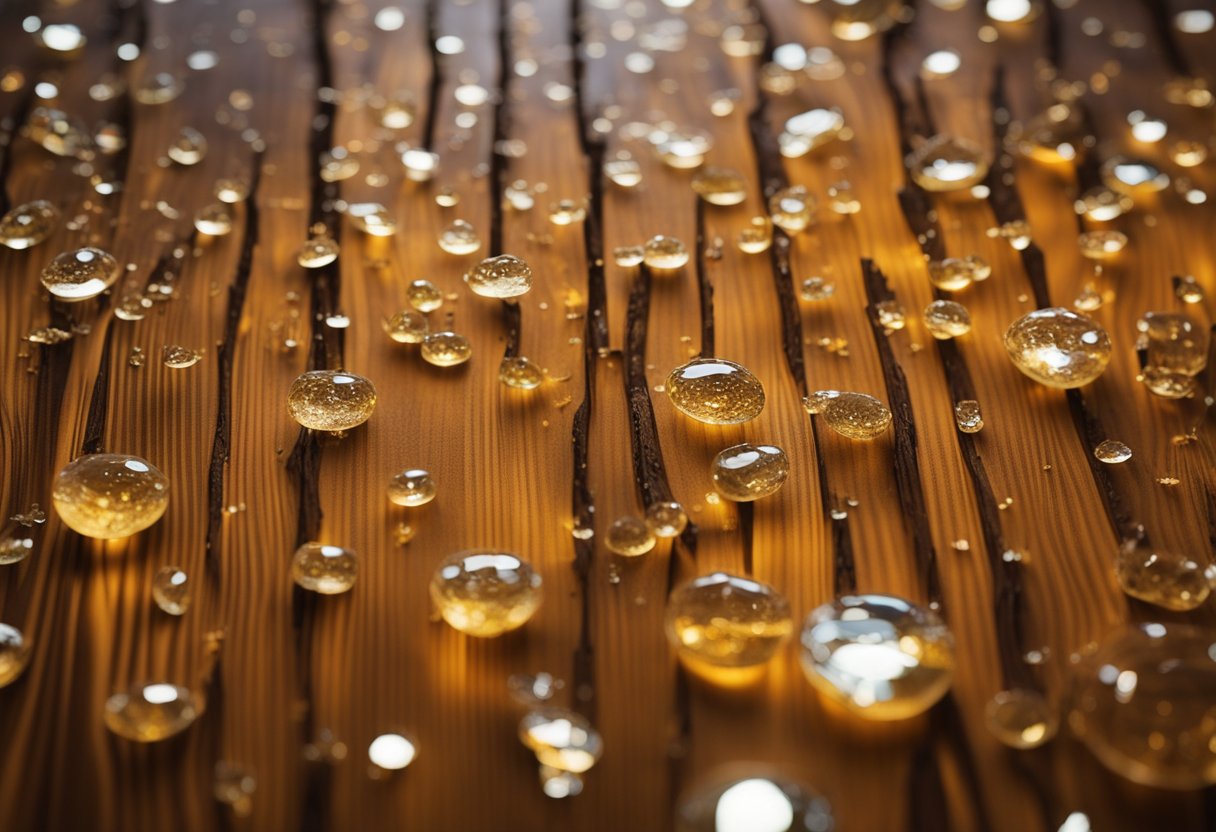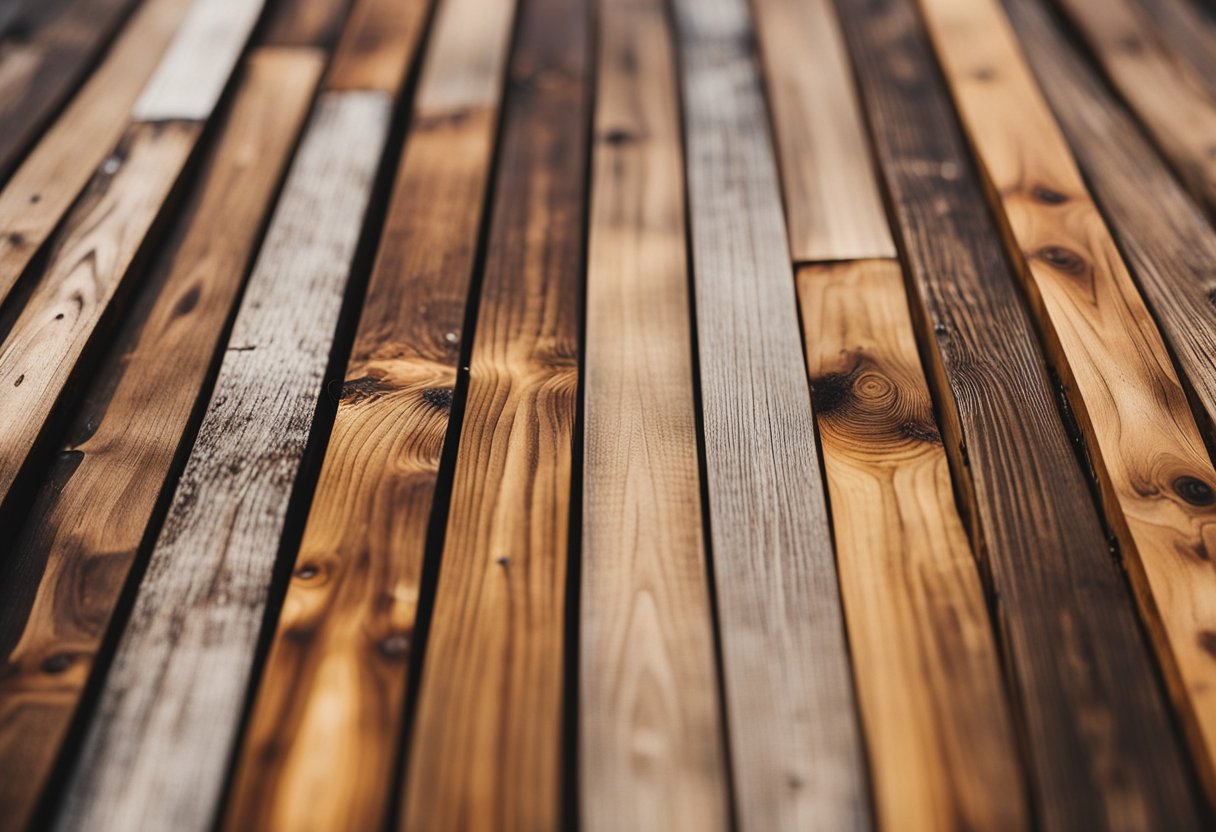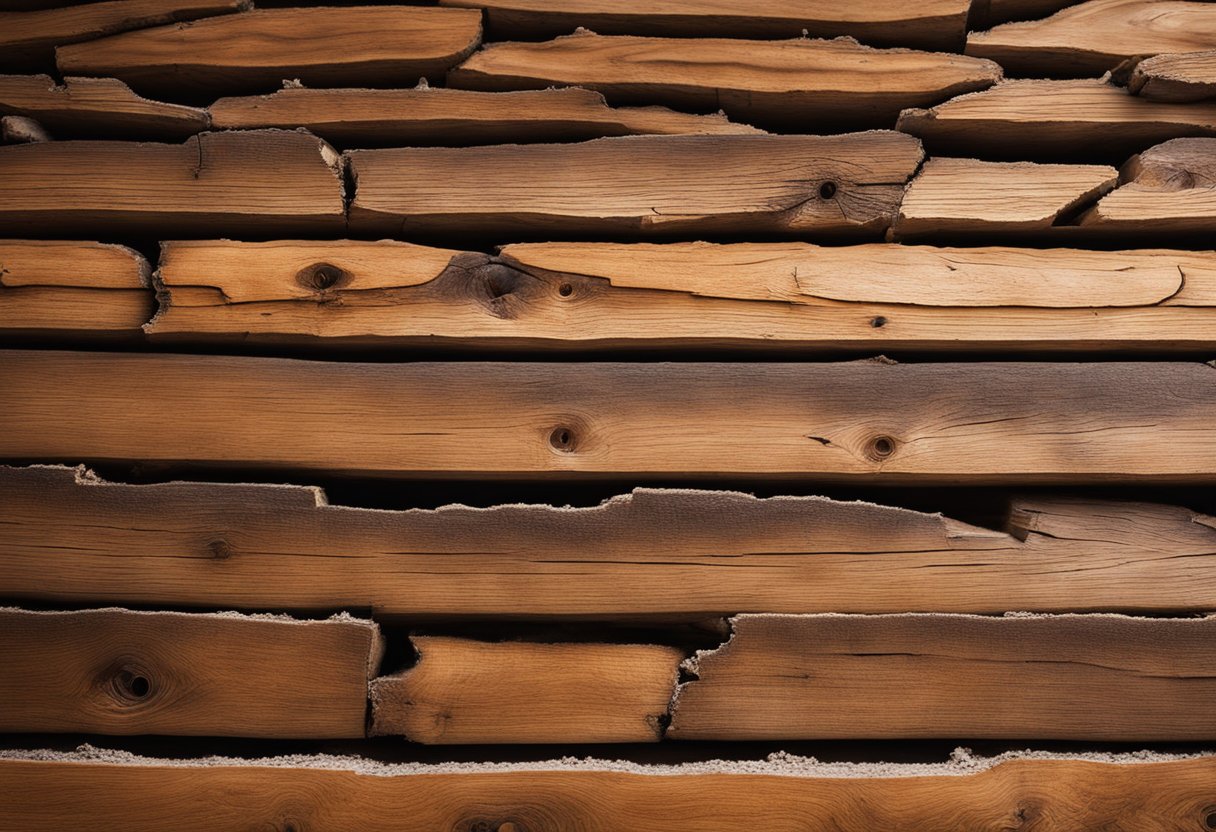If you’re a woodworker or DIY enthusiast, you may have encountered sap leakage from wood. Sap is a natural substance found in trees, and it can be a nuisance when it seeps out of wood, leaving behind sticky residue and staining the surface. Fortunately, there are ways to stop sap from coming out of wood and prevent it from happening in the future.
Understanding sap in wood is the first step in addressing the issue. Sap is a combination of water, sugar, and minerals that flows through the tree’s xylem and phloem. It serves as a transport system for nutrients and water, and it can also help protect the tree from insects and disease. When a tree is cut or damaged, sap can leak out of the wood, causing problems for woodworkers and homeowners. Different types of wood have varying levels of sap content, which can affect how much sap leaks out.
Key Takeaways:
- Understanding sap in wood is key to addressing sap leakage.
- Different types of wood have varying levels of sap content, which can affect how much sap leaks out.
- Methods to stop sap from coming out of wood include using heat, solvents, or sealers, and finishing the wood to prevent future leakage.
Understanding Sap in Wood
https://www.youtube.com/watch?v=PUckRqDfJfs&embed=true
As a woodworker, it’s important to understand the role sap plays in wood. Sap is a vital component of a tree’s circulatory system, transporting nutrients and water from the roots to the branches and leaves. It flows through the phloem, a layer of tissue just beneath the bark, and is responsible for the sweet taste of maple syrup and the sticky residue left on your hands after handling pine cones.
When a tree is cut down, the sap in the wood begins to dry out and solidify, forming what we commonly refer to as “wood sap.” This sap can sometimes seep out of the wood, causing a sticky mess that can be difficult to clean up.
There are a few reasons why sap might be coming out of your wood. One possibility is that the wood was not properly dried before it was used. Another possibility is that the wood has a high concentration of sap, such as with pine or spruce.
To prevent sap from coming out of wood, it’s important to choose the right type of wood for your project. Kiln-dried wood is less likely to contain sap, as the drying process helps to crystallize the sap and prevent it from oozing out. If you’re using untreated wood, you can try heating it with a heat gun to crystallize the sap and then seal the wood with a shellac-based sealer.
In summary, sap is an important component of a tree’s circulatory system, but can sometimes cause problems for woodworkers. By understanding the role of sap in wood and taking steps to prevent it from seeping out, you can ensure that your woodworking projects are successful and free from sticky messes.
Types of Wood and Their Sap Content
As a woodworker, it is essential to understand the different types of wood and their sap content. Some woods have a higher sap content than others, and this can affect how much sap comes out of the wood.
Softwoods
Softwoods, such as pine, fir, and spruce, have a higher sap content than hardwoods. This is because softwoods have a higher percentage of sapwood compared to heartwood. Sapwood is the outermost part of the tree, and it is responsible for transporting water and nutrients from the roots to the leaves. As a result, softwoods tend to have more sap coming out of the wood.
Hardwoods
Hardwoods, such as oak, maple, and cherry, have a lower sap content than softwoods. This is because hardwoods have a higher percentage of heartwood compared to sapwood. Heartwood is the innermost part of the tree, and it is responsible for providing structural support to the tree. As a result, hardwoods tend to have less sap coming out of the wood.
Green Wood vs. Kiln-Dried Wood
Green wood, which is freshly cut wood, tends to have a higher sap content than kiln-dried wood. This is because the sap has not had time to dry out. Kiln-dried wood, on the other hand, has had the sap removed during the drying process. As a result, kiln-dried wood tends to have less sap coming out of the wood.
Treated Wood vs. Untreated Wood
Treated wood, which has been treated with chemicals to prevent rot and insect damage, tends to have less sap coming out of the wood. This is because the chemicals used in the treatment process can affect the sap content of the wood. Untreated wood, on the other hand, tends to have a higher sap content and may require more effort to stop sap from coming out of the wood.
Understanding the sap content of different types of wood is essential for preventing sap from coming out of the wood. By choosing the right type of wood and understanding its sap content, you can minimize the amount of sap that comes out of the wood and ensure a successful woodworking project.
Causes of Sap Leakage
As a woodworker, I understand the frustration that comes with sap leakage. Sap leakage is a common problem that occurs when working with wood, and it can be caused by several factors. In this section, I will discuss the various causes of sap leakage.
Injury
Injury to the tree is one of the primary causes of sap leakage. When a tree is injured, it tries to heal itself by producing sap. If the injury is severe, the tree may produce more sap than it needs, leading to sap leakage.
Pruning
Pruning is another cause of sap leakage. When a tree is pruned, it produces sap to heal the wound. If the pruning is done incorrectly, it can cause the tree to produce more sap than it needs, leading to sap leakage.
Initial Moisture Content
The initial moisture content of the wood can also cause sap leakage. If the wood has a high moisture content, it can cause the sap to flow out of the wood. This is because the sap is more fluid when the wood has a high moisture content.
Incorrect Drying
Incorrect drying of the wood can also cause sap leakage. If the wood is not dried properly, it can cause the sap to flow out of the wood. This is because the sap is more fluid when the wood is not dried properly.
Not Enough Drying
Not drying the wood enough can also cause sap leakage. If the wood is not dried enough, it can cause the sap to flow out of the wood. This is because the sap is more fluid when the wood is not dried enough.
Heat and Time
Heat and time can also cause sap leakage. If the wood is exposed to high temperatures for an extended period, it can cause the sap to flow out of the wood. This is because the sap is more fluid when the wood is exposed to high temperatures for an extended period.
In conclusion, sap leakage can be caused by several factors, including injury, pruning, initial moisture content, incorrect drying, not enough drying, heat, and time. As a woodworker, it is essential to understand these causes to prevent sap leakage and ensure that your projects are of the highest quality.
Methods to Stop Sap from Coming Out
https://www.youtube.com/watch?v=2CyC7DcR_UU&embed=true
As a woodworker, I have encountered the problem of sap coming out of wood many times. It can be frustrating and difficult to deal with, but there are several effective methods to stop sap from coming out of wood.
Crystalize the Sap
One method to stop sap from coming out of wood is to crystalize the sap. If the sap is still in liquid form, you can mix sugar and water in a container until the sap is completely submerged. Then, wait for the sap to harden into crystals. Once it’s hardened, you can scrape it off of the wood. This method is effective for small amounts of sap.
Use Heat to Dissolve the Sap
Another method to stop sap from coming out of wood is to use a heat gun to crystallize the sap, then scrape it off. Clean any residue with a solvent like mineral oil or turpentine. This method is effective for larger amounts of sap. However, it is important to note that applying heat to the wood can have negative effects on the wood, such as warping or cracking.
Kiln Drying
Kiln drying wood to 170 F will crystallize most of the sap and prevent oozing. This method is effective for preventing sap from coming out of wood in the future. It is important to note that kiln-dried wood is more expensive than air-dried wood, but it is worth the investment if you want to prevent sap leakage.
Apply a Sealer
Applying a shellac-based sealer to the wood surface can also prevent sap from coming out of wood. Focus on knot areas, as they are more prone to sap leakage. This method is effective for preventing sap from coming out of wood in the future.
By using these methods, you can stop sap from coming out of wood and prevent future sap leakage. Choose the method that works best for your situation and always be careful when applying heat to the wood.
Cleaning and Removing Sap from Wood
https://www.youtube.com/watch?v=5nN22eP6T4Q&embed=true
When dealing with sap on wood, it’s important to act quickly to prevent it from hardening and becoming more difficult to remove. There are several methods for cleaning and removing sap from wood, depending on the severity of the problem and the type of wood involved.
One of the simplest methods for removing sap is to use a putty knife or scraper to gently scrape away any hardened sap crystals. Be careful not to damage the wood surface while doing this. Sandpaper can also be used to sand away the sap, but be sure to use a fine-grit sandpaper to avoid scratching the wood.
If the sap is still in liquid form, it can be crystalized using sugar [^1]. Once the sap has hardened, it can be scraped away using a putty knife or scraper. If the sap has already hardened, a cleaning solvent such as rubbing alcohol, mineral spirits, or turpentine can be used to dissolve and remove it [^2]. Be sure to test the solvent on a small, inconspicuous area of the wood first to make sure it doesn’t damage the finish.
For particularly stubborn sap stains or a sticky mess, a product like Goo Gone can be used [^3]. This product is specifically designed to break down sticky substances and can be very effective in removing sap from wood. Be sure to follow the instructions on the label carefully and test on a small area first.
It’s important to note that bleach should not be used to remove sap from wood. Bleach can damage the wood and cause discoloration. Instead, stick to solvents and cleaning products specifically designed for removing sap [^4].
Overall, cleaning and removing sap from wood can be a bit of a hassle, but with the right tools and techniques, it can be done quickly and effectively.
Finishing and Sealing Wood to Prevent Sap Leakage
https://www.youtube.com/watch?v=MAmye6pDRnc&embed=true
When it comes to preventing sap leakage from wood, finishing and sealing the wood is an effective solution. There are several options available for finishing and sealing wood, including using a sealer, shellac-based sealer, paint, stain, or polyurethane. Each of these options has its own advantages and disadvantages.
One of the best options for sealing wood to prevent sap leakage is a shellac-based sealer. A shellac-based sealer is a natural finish that is made from the secretions of the lac bug. It is known for its excellent sealing properties and its ability to prevent sap from seeping through the wood. It is also easy to apply and dries quickly.
Another option for sealing wood is polyurethane. Polyurethane is a synthetic finish that is known for its durability and resistance to water and other liquids. It provides a strong barrier against sap leakage and can be used on a variety of wood surfaces. However, it can be difficult to apply and can take longer to dry than other finishes.
When applying a sealer or finish to wood, it is important to follow the manufacturer’s instructions carefully. This will ensure that the finish is applied correctly and that it provides the best protection against sap leakage. It is also important to choose a high-quality sealer or finish to ensure that it provides long-lasting protection.
In conclusion, finishing and sealing wood is an effective way to prevent sap leakage. A shellac-based sealer or polyurethane are both good options for sealing wood, but it is important to choose a high-quality product and to follow the manufacturer’s instructions carefully. With the right finish or sealer, you can enjoy beautiful, sap-free wood surfaces for years to come.
Additional Tips and Considerations
When it comes to stopping sap from coming out of wood, there are a few additional tips and considerations to keep in mind. Here are some things to consider:
-
Dealing with excess sap: If you’re dealing with a lot of sap, it’s important to take the time to properly clean it up before attempting to stop the sap from coming out of the wood. Use a scraper or putty knife to remove any excess sap, and then clean the area with a solvent like mineral oil or turpentine.
-
Using a tarp: If you’re working with fresh wood, consider covering it with a tarp to prevent sap from leaking onto your deck or furniture. This can also help protect the wood from the elements while it dries.
-
Choosing the right sealer: When it comes to preventing sap leakage in the future, choosing the right sealer is key. Look for a shellac-based sealer, and pay special attention to knot areas where sap is more likely to leak out.
-
Working with deck boards: If you’re working with deck boards, it’s important to choose kiln-dried wood to prevent sap from leaking out. You can also use a deck sealer to protect the wood from moisture and prevent sap leakage.
-
Consider woodworking techniques: When working with wood pieces, consider using woodworking techniques like quarter-sawing or rift-sawing to minimize the amount of sap that can leak out.
By following these tips and considerations, you can effectively stop sap from coming out of wood and prevent sap leakage in the future.
Frequently Asked Questions
https://www.youtube.com/watch?v=Wp6ZHiV0cio&embed=true
How can I prevent sap from seeping out of wood?
Preventing sap from seeping out of wood involves using kiln-dried wood or applying a shellac-based sealer to the wood, focusing on knot areas. Kiln drying wood to 170 F will crystallize most of the sap and prevent oozing. If you aren’t able to buy kiln-dried wood, then heat the wood with a heat gun until the sap crystallizes, then seal the wood with the sealer of choice. Clean the sap off the wood with a solvent first.
What causes sap to leak out of wood?
Sap can leak out of wood due to injury to the tree, insect infestations, and fungal infections. For example, if you see sap coming out of the wood, it is most likely due to injury.
How do I stop sap from coming out of deck boards?
To stop sap from coming out of deck boards, you can use a sealant or a solvent to remove the sap. Applying a sealant to the deck boards will help prevent future sap leakage.
How do I remove sap from painted wood?
To remove sap from painted wood, you can use a solvent such as mineral oil or turpentine. Apply the solvent to the affected area and let it sit for a few minutes. Then, wipe away the sap with a clean cloth.
Why is my wood leaking sap and how do I fix it?
Wood can leak sap due to injury, insect infestations, and fungal infections. To fix it, you can use a solvent to remove the sap and then apply a sealant to prevent future sap leakage.
How can I paint over wood that is leaking sap?
To paint over wood that is leaking sap, you need to first remove the sap using a solvent such as mineral oil or turpentine. Once the sap is removed, apply a shellac-based sealer to the wood, focusing on knot areas. This will help prevent future sap leakage and allow you to paint over the wood.

Hi, I’m Sal Muller of Tooltrip.com. My DIY experience led me to understand essential power tools for home projects. Tooltrip.com guides enthusiasts and professionals in choosing right tools for any job. I provide concise top tool reviews for easier, efficient DIY.




